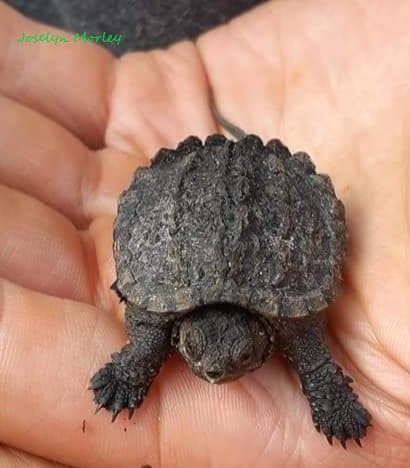One morning, I looked out my window to see my dogs barking at a big, flat rock in the grass. They’re not the brightest dogs, but even for them, that warranted some investigation. I dragged the dogs in, and waited a while. Sure enough, the big old snapping turtle eventually stuck her head out, and continued her slow crawl back towards the river. Another time while I was gardening, I looked up to see one of my dogs trotting along proudly with a treasure in her mouth. It was a painted turtle. She’d picked it up very gently from above. When I returned it to the riverbank with a quick apology on behalf of my dopey dogs, it was most likely mad, but unharmed.
Eight species of turtles call Ontario home. Seven of those species are endangered, threatened, or designated as a species of special concern. Wetlands are threatened in Ontario, due to development, draining watersheds and floodplains, agriculture, road building and expansion, mining, dumping and pollution, damming, and climate change. Turtles are threatened by the same forces that destroy their habitat. Alongside threats from natural predators such as raccoons or skunks, turtles are vulnerable due to habitat loss, hunting and poaching, and roads. Seven of these species of turtles can be found in the South Nation Watershed.
The Wood turtle, listed as endangered in Ontario, is the only turtle we do not find here. Turtles endangered in Ontario found in the South Nation Watershed are the Spotted Turtle, the Eastern Spiny Softshell Turtle, and the Blanding’s Turtles. The other four, which are designated as species of Special Concern, are the Northern Map Turtle, the Eastern Musk Turtle (or Stinkpot Turtle), the Snapping Turtle, and the Painted Turtle. They take 8 to 25 years to reach maturity, most live to 30 or 40 years, but some over 100. The sex of many turtles is dependent on incubation temperature. Long hot summers result in more female turtles, and is just one more way that climate change threatens this species.
Depending on the species, only between 1 and 7 of every 10 000 turtle eggs make it to adulthood. That is 0.01% to 0.07% survival rate. Turtles are killed in large numbers on Ontario roadways, as the adults lay eggs in the sand or gravel along the sides of roads and highways. The adult is vulnerable to traffic making the trek, and hatchlings can be hit as they make their way to the water.
Turtles on the road can look like bumps, rocks, or oil on the road. If you see one, give it space. Turn on your hazard lights to warn others. If if is safe to do so, you can help the turtle cross the road, always in the direction that it is travelling. Pick it up by holding both its plastron (underside) and carapace (topside) of the shell. Helping a turtle digging on the side of the road takes a while. Don’t move it. Just stick around if possible, and keep it safe from cars. Never pick up a turtle by its tail. You can dislocate its spine. Snapping turtles are a challenge to move, but it’s possible. Far back on the shell where the top meets the bottom, there is a place to grab firmly. They have really long necks, and can reach far. Don’t pick it up unless you’re confident. They crack if dropped on pavement! You can use a car mat, or blanket. Move the turtle onto the sheet, turn it around, and drag the mat or sheet backwards. Turn the turtle back to the way it was headed after it’s safely across.
An injured turtle needs medical attention ASAP. If you find an injured turtle, call the Ontario Turtle Conservation Centre at 705-741-5000. Put the injured turtle in a well-ventilated plastic container with a secure lid. Do not give it food or water. Note the location. Do the same for a deceased turtle. A female turtle could have eggs that could be incubated. Call the Centre.
The Eastern Box turtle is listed as vulnerable under the Species at Risk Ontario (SARO) listing. Ontario’s Endangered Species Act (ESA) of 2007 allowed for an assessment of a species’ status by the Committee on the Status of Species at Risk in Ontario (COSSARO). It is comprised of an independent scientific committee working in conjunction with Indigenous knowledge holders. Once a species was classified by COSSARO as threatened or endangered, it received a level of automatic legal protection. The ESA was far from perfect, but it was considered to have some power, especially when compared with other provinces.
In June 2019, the Ontario government passed the More Homes, More Choice Act, declaring that “many will be able to realize their dream of homeownership, while renters will see lower costs.” This act significantly crippled the ESA in several ways. The integrity of COSSARO was sacrificed by allowing input from individuals with claims to “community knowledge.” This can include anyone with interest in developing an ecologically significant area, for example. It changed how the species was looked at geographically, discounting distinct isolated populations, and the status of a species in Ontario.
A species status in Ontario can be ignored if there is a population elsewhere. Previous deadlines for designating a species at risk have been extended, and acceptance of repeated delays have been built into the system. Even after officially listing a species, the act allows a “delay of prohibitions upon initial listing,” allowing a further year’s delay. A further “temporary suspension of protection upon initial listing” allows the Minister the power to suspend protection for another three years. Under the guise of streamlining construction process, a broad landscape agreement allows for multiple activities on a larger geographical area under one permit. There are no limits on the size of a project, or the extent of activities. Finally, developers can pay into a Species-at-Risk Conservation Fund in exchange for habitat destruction. Payment to the Fund allows unchecked destruction.


